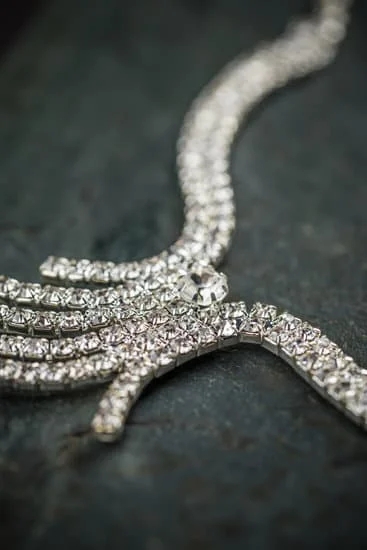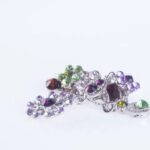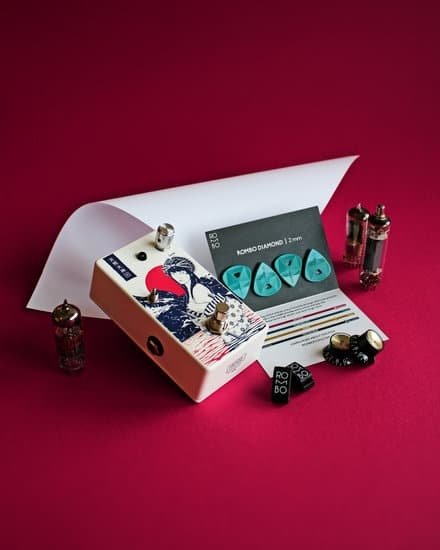The increasing popularity of fashion jewelry has brought about concerns regarding its tendency to turn green. This phenomenon has left many fashion enthusiasts puzzled and wondering why their favorite accessories develop an unsightly green tint over time. In this article, we will delve into the composition of fashion jewelry and explore the science behind the green coloration.
We will also discuss factors that influence this discoloration and provide tips on how to prevent it. Additionally, we will introduce alternative materials for non-green fashion jewelry, weigh the pros and cons of fashion jewelry, and offer advice on maintenance practices and purchasing choices. So, if you’ve ever wondered why your fashion jewelry turns green or how to avoid it altogether, keep reading.
Understanding the Composition of Fashion Jewelry
Fashion jewelry is a popular choice for many individuals as it offers affordable and stylish options to accessorize various outfits. However, one common concern with fashion jewelry is its tendency to turn green over time. Understanding the composition of fashion jewelry can shed light on why this discoloration occurs.
Fashion jewelry is made using a variety of materials, such as metals, gemstones, glass, and plastic. It often incorporates base metals like copper and brass due to their durability and affordability. These metals serve as the foundation for many fashion jewelry pieces but can contribute to the green coloration.
Copper, in particular, is prone to oxidization when exposed to moisture and oxygen in the air. This reaction forms copper oxide, which manifests as a green tint on the surface of the jewelry. Brass, commonly found in fashion accessories, also contains copper and can undergo a similar oxidation process.
To prevent or minimize the green discoloration caused by these metals, it is important to take certain measures. Applying a thin layer of clear nail polish onto areas that come into direct contact with the skin acts as a protective barrier against moisture and slows down oxidation.
Proper storage and cleaning methods are also crucial in maintaining the appearance of fashion jewelry. Storing individual pieces in separate compartments or pouches prevents them from rubbing against each other and causing damage. Regularly wiping down jewelry with a soft cloth after each use removes any moisture or sweat that may have accumulated on the surface.
Understanding that certain materials used in fashion jewelry can cause it to turn green empowers individuals to make informed choices when purchasing accessories. By opting for alternative materials like stainless steel or 925 sterling silver – which are less likely to oxidize – individuals can indulge in non-green options without compromising style or budget.
The Science behind Jewelry Turning Green
Fashion jewelry turning green is a common phenomenon that has puzzled many wearers. The mysterious green coloration often leaves people questioning the quality and composition of their jewelry. In this section, we will delve into the scientific explanation behind why fashion jewelry turns green.
The oxidation process is the key factor behind the green tint that appears on fashion jewelry. When metals such as copper and brass come into contact with moisture and oxygen, they undergo a chemical reaction that leads to oxidation. This reaction forms a layer of copper oxide or copper carbonate on the surface of the metal, resulting in the characteristic green color.
Various factors can influence the speed and extent of this oxidation process. Humidity and sweat are known to accelerate the reaction, making jewelry more prone to turning green in these conditions. Additionally, the acidity or pH level of an individual’s skin can also affect how quickly jewelry tarnishes.
To better understand how to prevent jewelry from turning green, it is important to consider these scientific factors. By implementing preventive measures such as applying clear nail polish as a protective barrier or storing and cleaning jewelry properly, wearers can mitigate the risk of green discoloration.
| Factors | Impact on Jewelry Tarnishing |
|---|---|
| Humidity and Sweat | Accelerates oxidation process; increases likelihood of green discoloration |
| pH Levels and Acidity | Affects rate at which oxidation occurs; higher acidity may lead to faster tarnishing |
Understanding the science behind jewelry turning green not only enables wearers to make informed purchasing decisions but also empowers them to effectively maintain their fashion accessories. By taking proactive steps and utilizing alternative materials such as stainless steel or 925 sterling silver, wearers can enjoy their fashion jewelry without the worry of green discoloration.
Factors Influencing the Green Coloration
When it comes to understanding why fashion jewelry turns green, it is important to consider the various factors that contribute to this phenomenon. While the oxidation process plays a significant role, other elements such as moisture, acidity, and pH levels can also influence the green coloration of jewelry. By being aware of these factors, individuals can take preventative measures to prolong the life and appearance of their fashion jewelry.
The Impact of Humidity and Sweat
One of the main culprits behind the green discoloration of fashion jewelry is moisture. When exposed to high humidity levels or when worn during physical activities that induce sweating, fashion jewelry can come into contact with water. This moisture reacts with metals like copper and brass commonly found in fashion jewelry, leading to oxidation and eventually resulting in a green tint on the skin.
The Role of pH Levels and Acidity
Another factor that influences the green coloration is the individual’s pH levels and skin acidity. The natural pH level of an individual’s skin can vary, and certain individuals may have more acidic skin than others. When acidic sweat or oils come into contact with fashion jewelry made from metals like copper or brass, a reaction occurs that accelerates oxidation. As a result, individuals with higher acidity levels are more prone to experiencing green discoloration when wearing fashion jewelry.
To prevent or minimize the green coloration caused by humidity, sweat, pH levels, and acidity, there are several tips individuals can follow:
- Remove jewelry before engaging in activities that may induce sweating or expose it to high levels of moisture.
- Keep your skin dry by using talcum powder or applying antiperspirant on areas where your jewelry comes into contact with your skin.
- Utilize barrier methods such as clear nail polish or protective sprays specifically designed for jewelry to create a layer between your skin and the metal.
- Consider opting for fashion jewelry made from alternative materials that are less prone to oxidation and green discoloration, such as stainless steel or hypoallergenic 925 sterling silver.
By understanding the factors that contribute to the green coloration of fashion jewelry, individuals can make informed choices and take steps to prevent or manage this discoloration. Taking preventative measures and investing in higher-quality materials can help individuals enjoy their fashion jewelry without worrying about unsightly green stains on their skin.
Tips to Prevent Fashion Jewelry from Turning Green
Fashion jewelry is a popular accessory choice for its affordability and trendy designs. However, one common concern among wearers is the green discoloration that can occur over time. Understanding the factors behind this color change and taking preventive measures can help extend the lifespan of fashion jewelry.
One effective tip to prevent fashion jewelry from turning green is to apply a layer of clear nail polish. Nail polish creates a barrier between the metal and moisture in the environment, slowing down the oxidation process.
This protective layer should be reapplied every few months or as needed. It’s important to note that this method works best for fashion jewelry that does not come into direct contact with skin, as it may cause an allergic reaction in some individuals.
Proper storage and cleaning methods are also key in preventing green discoloration. Storing fashion jewelry in a dry environment, such as a jewelry box or pouch, helps minimize exposure to moisture. Additionally, cleaning fashion jewelry regularly using mild soap and water can remove any residue or oils that may contribute to the oxidation process.
| Tips | Description |
|---|---|
| Apply clear nail polish | Creates a barrier against moisture and slows down oxidation |
| Store in dry environment | Minimizes exposure to moisture |
| Clean regularly with mild soap and water | Removes residue and oils that contribute to oxidation process |
Alternative Materials for Non-Green Fashion Jewelry
Introducing stainless steel as a corrosion-resistant option
One alternative material that can be used in fashion jewelry to avoid the issue of green discoloration is stainless steel. Stainless steel is known for its excellent corrosion resistance, making it less prone to oxidation and subsequent green tinting. This material consists of a combination of iron, chromium, and sometimes nickel, which forms a protective layer on the surface of the jewelry, preventing moisture and oxygen from reaching the metal beneath.
This protective layer also makes stainless steel highly durable and resistant to scratching or tarnishing. Additionally, stainless steel jewelry often comes in a wide range of designs and finishes, giving consumers plenty of options to choose from.
Showcasing hypoallergenic materials like 925 sterling silver
Another popular alternative for non-green fashion jewelry is 925 sterling silver. While pure silver may be susceptible to oxidation and turning green over time, sterling silver combines silver with other metals such as copper to create a more durable alloy.
The presence of copper helps enhance the strength and durability of the jewelry while reducing the risk of green discoloration. It is important to note that “925” refers to the hallmark indicating that the piece contains 92.5% pure silver, ensuring its authenticity.
Sterling silver also has hypoallergenic properties, making it suitable for individuals with sensitive skin who may experience irritation from other metals commonly found in fashion jewelry. With its elegant appearance and versatility, sterling silver offers an attractive option for those seeking non-green jewelry without compromising style.
By incorporating alternative materials like stainless steel and 925 sterling silver into their collections, jewelers can provide customers with fashionable pieces that are not prone to turning green. These alternatives offer a wider variety of choices to consumers who want stylish accessories that maintain their original look over time.
The Pros and Cons of Fashion Jewelry
Fashion jewelry offers many benefits to those who love accessorizing their outfits without breaking the bank. One of the major pros of fashion jewelry is its affordability. Unlike fine jewelry made with precious metals and gemstones, fashion jewelry is typically made with more cost-effective materials such as base metals, glass, or synthetic stones. This allows consumers to purchase a wide variety of trendy pieces without emptying their wallets.
Another advantage of fashion jewelry is the endless array of designs and styles available. Fashion trends are constantly evolving and changing, and fashion jewelry allows individuals to stay up-to-date with these trends without investing in expensive pieces. From statement necklaces to stackable rings, there is something for everyone’s personal style.
However, it’s important to acknowledge the potential drawbacks that come with fashion jewelry, one being the green discoloration that can occur on certain pieces. As discussed earlier in this article, fashion jewelry often contains metals like copper or brass that can react with moisture and oxygen, resulting in an oxidation process that turns the metal green. This can be especially frustrating for those who have sensitive skin or allergies to certain metals.
Despite this drawback, there are ways to prevent or manage the green discoloration of fashion jewelry. Applying a thin layer of clear nail polish onto the surface of a piece can act as a protective barrier between the metal and skin, helping to minimize any potential reaction. Additionally, properly storing and cleaning your fashion jewelry can also help prolong its lifespan and reduce the risk of discoloration.
Fashion Jewelry Maintenance and Longevity
Fashion jewelry can add the perfect finishing touch to any outfit, but it’s important to know how to properly care for and maintain your pieces in order to keep them looking their best. With a few simple practices, you can extend the lifespan of your fashion jewelry and prevent it from turning green.
First and foremost, regular maintenance is key. Cleaning your fashion jewelry on a consistent basis will help remove any dirt or oils that can build up over time and contribute to discoloration. You can use mild soap and water, or a specialized jewelry cleaning solution, along with a soft cloth or toothbrush to gently scrub away any grime. Avoid using harsh chemicals or abrasive materials that could damage the surface of your jewelry.
Proper storage is also essential for maintaining the longevity of your fashion jewelry. When not in use, store your pieces in a cool and dry place, away from direct sunlight or excessive humidity. This will help prevent exposure to moisture, which can accelerate the oxidation process and lead to the green discoloration commonly seen in fashion jewelry.
In addition to regular cleaning and storage, there are a few other tips you can follow to prevent your fashion jewelry from turning green. Applying a thin layer of clear nail polish over the metal parts of your jewelry can act as a protective barrier against moisture and oxygen. This simple trick can significantly reduce the likelihood of discoloration. Furthermore, avoid wearing fashion jewelry while swimming or showering as prolonged exposure to water can hasten oxidation.
By following these maintenance practices, you can ensure that your fashion jewelry stays beautiful and vibrant for years to come. Remember that while you may love the affordable price tag and trendy designs of fashion jewelry, it’s important to balance style with quality when making purchasing decisions. By investing in high-quality pieces from reputable sources, you’ll be more likely to enjoy long-lasting wear without having to worry about green discoloration.
The Role of Quality and Authenticity in Jewelry Turning Green
When it comes to the issue of fashion jewelry turning green, the quality and authenticity of the jewelry itself play a significant role. It is important for consumers to understand that not all fashion jewelry is created equal, and the materials used can greatly impact the likelihood of green discoloration occurring.
One key factor to consider when evaluating the quality of fashion jewelry is the presence of certain metals like copper and brass. These metals are often used as base materials in fashion jewelry due to their affordability and malleability.
However, they are also prone to oxidation, which can lead to the green tint commonly associated with fashion jewelry. Higher-quality fashion jewelry may use coatings or platings, such as gold or silver, to prevent direct contact between these metals and the skin, reducing the chances of oxidation.
Furthermore, purchasing from reputable sources is crucial in ensuring that the fashion jewelry you buy is genuine and made with high-quality materials. Counterfeit or low-quality fashion jewelry may be more susceptible to turning green due to subpar manufacturing processes or inferior materials used. It is always worth investing time in researching trusted brands and sellers who value authenticity and prioritize quality control.
Conclusion
In conclusion, it is important for consumers to make informed choices when it comes to fashion jewelry in order to avoid the problem of green discoloration. By understanding the composition of fashion jewelry and how metals react with moisture and oxygen, individuals can take steps to prevent their jewelry from turning green.
Factors such as humidity, sweat, pH levels, and acidity also play a role in the green coloration of fashion jewelry. By considering these factors and implementing preventive measures like using clear nail polish as a protective layer and practicing proper storage and cleaning methods, individuals can maintain the appearance of their fashion jewelry for longer periods of time.
Furthermore, alternative materials like stainless steel and hypoallergenic options such as 925 sterling silver provide non-green alternatives to traditional fashion jewelry. These materials are known for their corrosion resistance and durability, making them ideal choices for individuals who want to avoid green discoloration.
In making jewelry choices, it is essential to consider both style and quality. While fashion jewelry offers affordability and trendy designs, it is important to be mindful of the potential drawbacks such as green discoloration. By purchasing from reputable sources and avoiding counterfeit or low-quality jewelry, individuals can ensure that they are investing in pieces that will not turn green easily.
In summary, by understanding the science behind jewelry turning green and implementing preventive measures, individuals can enjoy their fashion jewelry without worrying about discoloration. With a balance between style and quality, consumers can make informed choices when purchasing fashion jewelry that will last longer and retain its original beauty.
Frequently Asked Questions
Does the green from fake jewelry go away?
The green color that often appears on fake jewelry is typically due to a chemical reaction between the metal in the jewelry and the acids present in our skin, as well as exposure to moisture and air. Unfortunately, this green discoloration does not go away on its own. Once it appears, it can be challenging to remove.
While some home remedies or cleaning solutions may help lessen the green hue temporarily, they are unlikely to completely eliminate it. In most cases, if your fake jewelry has turned green, it is best to replace it or opt for higher-quality pieces.
How do I keep my costume jewelry from turning green?
To prevent your costume jewelry from turning green, there are several precautions you can take. Firstly, avoid exposing your jewelry to water or moisture as much as possible since this can accelerate the oxidation process that leads to discoloration. It’s also advisable to remove your jewelry before swimming or bathing.
Additionally, keep your costume jewelry dry by wiping it gently with a soft cloth after each use and store it in a cool and dry place away from humidity when not wearing it. Another helpful tip is to apply a thin coat of clear nail polish on any part of the jewelry that comes into direct contact with your skin since this extra layer can act as a barrier and reduce oxidization.
What kind of jewelry doesn’t turn green?
Jewelry made from metals such as sterling silver, gold (both solid gold and gold-plated), platinum, titanium, or stainless steel are less likely to turn green compared to cheaper materials commonly used in costume jewelry such as copper or brass alloys which tend to oxidize more easily. These higher-quality metals offer better resistance against tarnishing and discoloration caused by chemical reactions with our skin or environmental factors like humidity and oxygen exposure.
Additionally, certain gemstones like diamonds, sapphires, rubies, and emeralds are also excellent choices for resisting discoloration since they are durable and do not react strongly with moisture or acidic substances found naturally on our skin.

Welcome to my jewelry blog! My name is Sarah and I am the owner of this blog.
I love making jewelry and sharing my creations with others.
So whether you’re someone who loves wearing jewelry yourself or simply enjoys learning about it, be sure to check out my blog for insightful posts on everything related to this exciting topic!





